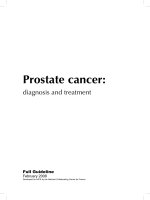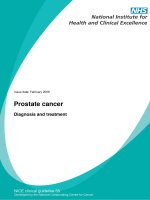Esophageal Cancer – Cell and Molecular Biology, Biomarkers, Nutrition and Treatment Edited by Ferdous Rastgar Jazii Published pdf
Bạn đang xem bản rút gọn của tài liệu. Xem và tải ngay bản đầy đủ của tài liệu tại đây (5.93 MB, 256 trang )
ESOPHAGEAL CANCER –
CELL AND MOLECULAR
BIOLOGY, BIOMARKERS,
NUTRITION AND
TREATMENT
Edited by Ferdous Rastgar Jazii
Esophageal Cancer – Cell and Molecular Biology,
Biomarkers, Nutrition and Treatment
Edited by Ferdous Rastgar Jazii
Published by InTech
Janeza Trdine 9, 51000 Rijeka, Croatia
Copyright © 2012 InTech
All chapters are Open Access distributed under the Creative Commons Attribution 3.0
license, which allows users to download, copy and build upon published articles even for
commercial purposes, as long as the author and publisher are properly credited, which
ensures maximum dissemination and a wider impact of our publications. After this work
has been published by InTech, authors have the right to republish it, in whole or part, in
any publication of which they are the author, and to make other personal use of the
work. Any republication, referencing or personal use of the work must explicitly identify
the original source.
As for readers, this license allows users to download, copy and build upon published
chapters even for commercial purposes, as long as the author and publisher are properly
credited, which ensures maximum dissemination and a wider impact of our publications.
Notice
Statements and opinions expressed in the chapters are these of the individual contributors
and not necessarily those of the editors or publisher. No responsibility is accepted for the
accuracy of information contained in the published chapters. The publisher assumes no
responsibility for any damage or injury to persons or property arising out of the use of any
materials, instructions, methods or ideas contained in the book.
Publishing Process Manager Romana Vukelic
Technical Editor Teodora Smiljanic
Cover Designer InTech Design Team
First published March, 2012
Printed in Croatia
A free online edition of this book is available at www.intechopen.com
Additional hard copies can be obtained from
Esophageal Cancer – Cell and Molecular Biology, Biomarkers, Nutrition and Treatment,
Edited by Ferdous Rastgar Jazii
p. cm.
ISBN 978-953-51-0223-6
Contents
Preface IX
Chapter 1
Molecular Biology Character
of Esophageal Cancer 1
Mingzhou Guo, Yan Jia and Wenji Yan
Chapter 2
Growth Factors, Signal
Transduction Pathways, and Tumor
Suppressor Genes in Esophageal Cancer 21
Maryam Zare, Mehdi Moghanibashi and Ferdous Rastgar Jazii
Chapter 3
Biomarkers, Stem Cells
and Esophageal Cancer 49
Irene Vegh and Ana I. Flores
Chapter 4
Proteomics and Esophageal Cancer
Mehdi Moghanibashi, Maryam Zare
and Ferdous Rastgar Jazii
Chapter 5
The Interaction Between the Metabolism of Retinol
and Ethanol in Esophageal Mucosa – A Possible
Mechanism of Esophageal Cancer in Alcoholics 101
Hirokazu Yokoyama, Haruko-Shiraishi Yokoyama
and Toshifumi Hibi
Chapter 6
Study on the Dietary
Factors of Esophageal Cancer 127
Guiju Sun, Tingting Wang, Guiling Huang,
Ming Su, Jiasheng Wang, Shaokang Wang and Fukang Liu
Chapter 7
Current Therapy for
Esophageal Adenocarcinoma 153
Yoshihiro Komatsu and Michael K. Gibson
Chapter 8
Nonsurgical Management
of Esophageal Cancer 171
Malek M. Safa and Hassan K. Reda
79
VI
Contents
Chapter 9
Emerging Therapies for Esophageal Cancer
Hajime Orita, Malcolm Brock and Koichi Sato
207
Chapter 10
Multiple Early-Stage Malignant Melanoma
of the Esophagus with a Long Follow-Up
Period After Endoscopic Treatment:
Report of a Case and a Literature Review 227
Shin’ichi Miyamoto, Shuko Morita and Manabu Muto
Chapter 11
Pulmonary Edema Induced by Esophagectomy 239
Yusuke Sato, Satoru Motoyama and Junichi Ogawa
Preface
With particular distribution in the world and hundreds fold variation in the incidence
rate between the high and low risk regions it is well established that both
environmental factors as well as genetic predisposition are involved in tumorigenesis
of esophageal cancer. As a result environmental, nutritional, habitual, and socioeconomic factors, as well as cell and molecular alterations have to be subject of
investigations in the etiology of this type of cancer. At molecular level, while a large
number of alterations have so far been proposed for esophageal carcinogenesis,
however several specific events were attributed to be more significant and key players
of the role in the process of esophageal carcinogenesis. These events are specific
molecular mechanisms and pathways involved in the regulation of the both oncogenes
and tumor suppressor genes.
The present book covers recent achievements in the cell and molecular, nutritional, in
addition to clinical features of esophageal cancer. The first two chapters of the book
describe fundamental features including genetic, cellular and molecular aspects of
esophageal cancer. Chapter three and four have aimed candidate molecular markers of
esophageal cancer. Chapter three describes the present molecular marker in addition
to the role of stem cell biology in the identification of biomarkers. Chapter four has
focused on the application of proteomic in the etiology and identification of tumor
markers regarding esophageal cancer; the present identified marker and future
prospects.
Chapter five and six have oriented toward dietary and metabolic pathways. In chapter
five our present knowledge of structural and functional features of retinoic acid and
effect of ethanol metabolic pathway on retinoic acid supply in pathogenesis of
esophageal cancer is discussed. Chapter six has focused on a long term case-control
cohort study on the role of different nutritional factors, minerals, vitamins in
esophageal cancer.
The last five chapters are dedicated to the clinical features of esophageal cancer.
Chapter seven and eight have focused on the histo-pathological features, diagnosis as
well as current therapies of esophageal cancer and chapter nine on the application of
recent achievements in the cell and molecular biology based targeted cancer therapy.
Chapter ten and eleven have briefly focused on the two especial features of esophageal
X
Preface
cancer which have received less attention in the literatures. In chapter ten a case report
of primary malignant melanoma of the esophagus (PMME), a rare disease diagnosed
in the advanced stage years after the first diagnosis is discussed and finally the last
chapter has focused on the importance of recognition and monitoring Extravascular
Lung Water using PiCCO system during preoperative managements of
esophagectomy with extensive lymph node dissection for thoracic esophageal cancer.
Dr Ferdous Rastgar Jazii
Associate Professor, Faculty at the National Institute
of Genetic Engineering and Biotechnology of Iran (NIGEB),
Iran
Research Fellow, Department of Molecular Structure and Function,
Hospital for Sick Children Research Institute, Toronto,
Canada
1
Molecular Biology Character
of Esophageal Cancer
Mingzhou Guo, Yan Jia and Wenji Yan
Department of Gastroenterology & Hepatology,
Chinese PLA General Hospital
China
1. Introduction
Esophageal cancer (EC) is the eighth most common cancer and the sixth most common
cause of cancer death worldwide. Esophageal squamous cell carcinoma (ESCC) and
adenocarcinoma (EAC) are two major histopathological type of esophageal cancer. The
incidence of EC was increased in the past 3 decades. Five-year survival of advanced cancer
is still very poor, even though improved surgical techniques and adjuvant chemoradiation
therapy. It is very important to understand esophageal cancer biology.
2. Genetic changes in esophageal cancer
Genetic change is one of the major events in transforming normal esophageal epithelia to
malignant cells. Mutations and genetic polymorphisms in coding gene sequences may cause
functional alteration of genes. Functional mutation and single nucleotide polymorphism
(SNP) (eg.p53, SULT1A1, CYP3A5, ALDH2, ADH1B1 and ECRG1) is related to
susceptibility of esophageal cancer.
2.1 Effects of mutations and SNPs in esophageal cancer
P53 is involved in multiple cellular pathways including apoptosis, transcriptional
regulation, and cell cycle control. Alterations in p53 have been reported to occur at an early
stage of EC. P53 mutation was observed in exon 5 and accounted for about 77% of ESCC
patients (Hu, Huang et al., 2001). Fanconi gene family is another interesting example. The
risk of ESCC is associated with both heterozygous and homozygous mutations in several
Fanconi anemia-predisposing genes, such as heterozygous insertion/deletion mutations in
FANCD2 (p.Val1233-del), FANCE (p.Val311SerfsX2) and FANCL (p.Thr367AsnfsX13)
(Akbari et al., 2011).
SNPs in p53 pathway also play important roles in EC tumorigenesis. SNP in p53 gene
(Arg72Pro) decreased apoptosis and was associated with increased risk, earlier age of onset,
reduced response to chemotherapy and early recurrence in esophageal cancers (Pietsch et
al., 2006). T309G is located in the promoter region of MDM2, which is the regulator of p53
pathway. Transcription factor may easily bind to the G variant of MDM2, increase MDM2
2
Esophageal Cancer – Cell and Molecular Biology, Biomarkers, Nutrition and Treatment
expression and reduce apoptosis in response to DNA damage (Bond et al., 2004). MDM2
T309G G/G was associated with an increased risk of death in ESCC (Cescon et al., 2009).
SNPs in key genes are associated with EC, such as genes involved in nucleotide excision
repair (NER) and base excision repair (BER) pathways. The increasing number of variant
alleles in SNPs of NER showed a significant trend to EAC, including XPD Lys751Gln,
ERCC1 8092 C/A and ERCC1 118C/T (Tse et al., 2008). Esophageal cancer related gene 1
(ECRG1) is reported as a novel tumor suppressor. ECRG1 is normally expressed in
esophagus, but reduced in ESCC. ECRG1 (Arg290Gln) was identified as the susceptible SNP
of ESCC (Li et al., 2006). It has been found that the increased risk of ESCC relates to
combined SULT1A12*2 genotype and CYP3A5 heterozygous genotypes, especially in
tobacco smokers (Dandara et al., 2006). SNP of ATP-binding cassette sub-family B
(MDR/TAP) member 1 gene (ABCB1) was reported to be associated with lymph node and
distant metastases in EC (Narumiya et al., 2011). SNP also impacted disease-free survival
(DFS) of ECs. The MDM2 T/G and CDH1 GA/GA genotype confer risk of death in EAC
patients (Boonstra et al., 2011). Vascular endothelial growth factor (VEGF) 936C/T is
associated with an improved overall survival compared with wild type genotype in EC
(Bradbury et al., 2009).
2.2 Effects of chromosomal abnormalities in esophageal cancer
Genomic alterations, such as amplification, deletion, translocation and loss of heterozygosity
(LOH) play an important role in initiation and progression of cancer. Recently a panel of
chromosome instability biomarkers, including LOH and DNA content, has been reported to
identify patients at high and low risk of progression from Barrett's esophagus (BE) to EAC
(Paulson et al., 2009).
Chromosomal aberrations have been discovered in BE and EAC, including frequent gain of
chromosomes 6p (10–37%), 7q (17–37%), 7p (30–60%), 8q (50–80%), 10q (20–50%), 15q (10–
40%), 17q (30–50%), and 20q (50–80%); and frequent loss of chromosomes 4q (20–50%), 5q
(20–50%), 9p (20–50%), 14q (30–40%), 16q (36–40%), 17p (30%), 18q (20–60%) and Y (60–
76%). The proto-oncogenes are often duplicated, such as MYC (8q), EGFR (7p) and ERBB2
(17q). But tumor suppressor genes are usually deleted in BE and EAC, including APC,
CDKN2A, p53, and SMAD4 (Akagi et al., 2009). Genomic instability varied widely across
chromosomal arms, with the highest frequency of LOH on 9p, CN (copy numbers) loss on
3p, and CN gain on 3q in ESCC (Hu et al., 2009).
ERBB2 and Topoisomerase (DNA) II alpha (TOP2A) genes are located in 17q12-q21.2 region
which was reported to be amplified in EACs. Amplification of ERBB2 was found in 10% to
70% of EAC samples. Antagonist of ERBB2, Trastuzumab/Herceptin, inhibits growth of
OE19 EAC cell line, which exhibits high expression of ERBB2. TOP2A gene is associated
with cell proliferation, and amplified TOP2A has been reported in ESCC (Akagi et al., 2009).
The epidermal growth factor receptor (EGFR) I, a tyrosine kinase (TK) involved in several
tumor progression and may serve as an important therapeutic target (Erlotinib, Cetuximab).
Homogeneous EGFR amplification defines a subset of aggressive Barrett's adenocarcinoma
with poor prognosis (Marx et al., 2010). Numerous studies have been reported that
chromosomal abnormalities (aneuploidy and tetraploidy) and loss of heterozygosity (LOH)
Molecular Biology Character of Esophageal Cancer
3
may be used as biomarkers to predict progression of Barrett’s esophagus to EAC (Reid et al.,
2000). It was demonstrated that a number of SNPs was highly correlated with chromosomal
abnormalities in Barrett’s esophagus and EAC (Li et al., 2008).
3. Epigenetic changes in esophageal cancer
The term epigenetics refers to the study of heritable changes in gene expression without
changes in gene sequence. In addition to genetic alteration, epigenetic modifications are
recognized as a common molecular alteration in human cancers. DNA methylation and
histone modifications are important epigenetic changes during tumor initiation and
progression (Sadikovic et al., 2008). Non-coding RNA (ncRNA) is another kind of epigenetic
regulation factor, especially microRNA (miRNA) was recently regarded as the important
gene expression regulator. Epigenetic regulation was involved in different pathways
including cell cycle, apoptosis, DNA repair et al (W. Zhang et al., 2008; X. Zhang et al., 2010).
3.1 DNA methylation
DNA methylation leads to gene silencing either by directly block the transcriptional factors
binding to DNA, or by MBP which recruits chromatin remodeling co-repressor complexes
(Klose & Bird, 2006). Promoter region methylation was reported frequently in human
esophageal cancer. DNMT1, DNMT3A and DNMT3B have been identified as DNA
methytransferases in eukaryotic cells. DNMT1 is involved in maintaining DNA methylation,
DNMT3A and DNMT3B are responsible for de novo methylation. Overexpression of these
DNMTs were reported to be involved in a variety of cancers including EC (Kassis et al.,
2006). DNMT3L and DNMT2 were reported recently related to DNA methylation. DNMT3L
is required for the methylation of imprinted genes in germ cells, and interacts with DNMT3a
and 3b in de novo methyltransferase activity (Chen et al., 2005). And the function of DNMT2
remains unclear, its strong binding to DNA suggests that it may mark specific sequences in
the genome.
Methylation profile is different in ESCC and EAC. Adenomatous polyposis coli (APC) is
frequently methylated in EAC, but infrequently in ESCC (Zhang & Guo, 2010).
CDKN2A/p16INK4a methylation is a frequent and early event both in ESCC and EAC (Wang
et al., 2009). Caudal type homeobox 2 (CDX2) is expressed in gut epithelia and plays an
important role in establishing intestinal phenotype during development. CDX2 is frequently
methylated in ESCC (49%), but rarely in EAC (5%) (Guo et al., 2007). Inactivation of CDX2 in
EC associated with DNA methylation may be an important determinant of squamous or
non-adenomatous phenotype. Multiple genes methylation increases during progression
from esophageal mucosa to EC [Figure1] (Fang et al., 2007; Guo et al., 2006). No RARβ2
methylation was observed in normal esophagus but increased methylation was found with
the progression of esophageal carcinogenesis. Hypermethylation of p16 and APC is related
to high-grade dysplasia or cancer in BE patients.
There is considerable epidemiological evidence suggesting that alcohol, tobacco, diets
deficient in vitamins/protective antioxidants, carcinogens and thermal injuries are
important in the pathogenesis of EC. Cigarette smoke is a key factor in esophageal
carcinogenesis. It was reported that cigarette smoking is a cause of SSBP2 promoter
4
Esophageal Cancer – Cell and Molecular Biology, Biomarkers, Nutrition and Treatment
methylation and that SSBP2 harbors a tumor suppressive role in ESCC through inhibition of
Wnt signaling pathway (Huang et al., 2011). A previous study demonstrated that duration
of tobacco smoking is correlated significantly with DNA methylation of HOXA9, MT1M,
NEFH, RSPO4, and UCHL1 in the background esophageal mucosa of EC patients (Oka et
al., 2009).
ED: esophageal dysplasia; EC: esophageal cancer
Fig. 1. Accumulated methylation of genes in the progression of esophageal cancer.
3.2 Histone modification
Histone modification (acetylation, methylation, phosphorylation, ubiquitylation, et al.) has
important functions in many biological processes including heterochromatin formation, Xchromosome inactivation and transcriptional regulation. In mammals histone arginine
methylation is found on residues 2, 8, 17 and 26 of histone H3 and residue 3 of histone H4.
Histone lysine methylation occurs on histones H3 and H4 and can be mono-, di- or
trimethylated. Similar to histone lysine methylation, arginine methylation occurs in monomethyl, symmetrical di-methyl or asymmetrical di-methyl state, and contributes to both
active and repressive effects on chromatin function (Martin & Zhang, 2005). Methylation on
the same site can lead to different outcomes depending on the number of methyl groups
added. However the functional relevance of these modification states remains poorly
understood. Although there is no evidence that lysine methylation directly affects chromatin
dynamics, acetylation of lysine residues in histones is reported to antagonize folding of
chromatin in vitro (Hansen, 2002). In mice, for example, it has been shown that pericentric
heterochromatin is specifically enriched in trimethyl-H3-K9 and H4-K20, and the effect is
silencing of transcription; while mono- and dimethyl-H3-K9 and H4-K20 are found in
euchromatin, and play activating transcriptional function, even though there some argues
(Peters et al., 2003; Schotta et al., 2004). The main sites of lysine methylation that have been
associated with gene activity include K4, K36 and K79 of histone H3. Trimethylation of
lysine 27 on histone H3 (H3K27me3) is an silencing epigenetic marker.
Molecular Biology Character of Esophageal Cancer
5
Acetylation neutralizes the positive charge of lysine, it has been suggested that this
modification might operate through an electrostatic mechanism and histone acetylation is
associated with active gene transcription. DNA methylation and histone modifications have
recently been reported to cooperate in controlling gene expression (Johnson et al., 2002).
Methylation of histone H3 lysine 9 was triggered by DNA methylation. DNA
methyltransferases have been shown to interact with histone deacetylases (HDAC), histone
methyltransferases, and methyl-cytosine-binding proteins in complex network (Fuks et al.,
2000). Histone modifications and DNA methylation are epigenetic phenomena that play a
critical role in neoplastic processes.
H3K18Ac and H3K27triMe was correlated with worse survival of ESCC, especially in early
stages patients (Langer et al., 2009). Zester homolog 2 (EZH2) is reported to be
overexpressed and correlates with poor prognosis in human cancers. The expression
frequency and expression levels of H3K27me3 were significantly higher in ESCCs than in
normal tissues by immunohistochemistry. Expression of H3K27me3 was significantly
correlated with WHO grade, tumor size, T status, locoregional progression and EZH2
expression. High expression level of H3K27me3 was significantly associated with poor
locoregional progression-free survival (LPFS) in ESCC (He et al., 2009). A study of 237 ESCC
patients showed that histone modifications have significant effects on recurrence-free
survival (RFS) after esophagectomy in ESCC, such as acetylation of histone H3 lysine9
(H3K9Ac), histone H3 lysine 18 (H3K18Ac), and histone H4 lysine 12 (H4K12Ac), and the
dimethylation of histone H3 lysine 9 (H3K9diMe) and histone H4 arginine 3 (H4R3diMe).
1% increased global level of H3K18Ac in pathologic stage III worsened RFS at 1.009 times,
after adjusting for age, sex, and operative method (I et al., 2010). Global levels of histone
modifications in ESCC may be an independent prognostic factor of RFS.
3.3 Non-coding RNA
Non-coding RNAs (ncRNAs) are functional RNA molecules that do not code for proteins.
Based on size, they are divided into different classes: long ncRNAs (lncRNAs), Piwiinteracting RNAs (piRNAs), small interfering RNAs (siRNAs), microRNAs (miRNAs), etc
(Brosnan & Voinnet, 2009). NcRNAs were regarded as important factors of cancer. MiRNA
is only well-studied ncRNAs in different disease, including esophageal cancer. MiRNAs are
a class of single stranded, evolutionarily conserved non-coding RNAs, only 17-25
ribonucleotides long, involved in a wide spectrum of basic cellular activities through their
negative regulation of gene expression.
MiRNAs play important roles in cellular activities such as proliferation, apoptosis and
differentiation (Bartel, 2004). MiRNAs are involved in the development, progression and
prognosis of esophageal cancers (Feber et al., 2011). As shown in Table 1, expression of
miRNAs is different in EAC and ESCC. It was reported that miR-25, miR-151 and miR-424
were up-regulated, whereas miR-29c, miR-99a and miR-100 were reduced in EC. The
pattern of these miRNAs may be used to distinguish malignant from normal esophagus.
Low level of miR-103/107 expression showed a strong correlation with high overall and
disease-free survival periods for EC patients, which may be used for the diagnosis of
esophageal cancer. Higher level of miR-196a was observed in EAC, BE and dysplastic
lesions compared with normal mucosa. MiR-145, miR-133a and miR-133b inhibited cell
6
Esophageal Cancer – Cell and Molecular Biology, Biomarkers, Nutrition and Treatment
proliferation and invasion in ESCC. MiR-200a has been linked to the etiology and prognosis
of ESCC. Expression levels of mature miR-21 and mature miR-145 were significantly higher
in ESCC than those in normal epithelium, and were significantly associated with lymph
node positive, recurrence and metastasis in ESCC (Akagi et al., 2011; Guo et al., 2008; Kano
et al., 2010; Maru et al., 2009).
Pathological
type
EAC
Overexpression
Downregulation
miR-215, miR-560,
miR-615-3p, miR-192,
miR-326, miR-147
miR-145, miR-133a,
miR-133b
miR-100, miR-23a,
miR-605, miR-99a,
miR-205, let-7c,miR-203
Let-7
ESCC,
EAC
miR-21
miR-375
ESCC
miR-93
miR203,miR205
ESCC
miR-373, miR-129
miR-10a
ESCC
Predicted targets of
miRNAs
Reference
HMGA2 (let-7c),
ZEB1 and ZEB2 (miR-205)
(Fassan et al.,
2010)
FSCN1(miR-145,miR-133a,
miR-133b) HMGA2 (Let-7)
(Kano et al.,
2010; Liu et
al., 2011)
PDCD4, NFIB, PTEN,
(Mathe et al.,
TPM1 (miR-21);
2009;
PDK1 (miR-375)
Matsushima
et al., 2010)
(Feber et al.,
FUS1, E2F1, TP53INP1
(miR-93); ΔNp63 (miR-203) 2008; Yuan et
al., 2011)
Rab11, APC, LATS2
(Matsushima
(miR-373); LATS2 (miR-129) et al.,
HOX family (miR-10a)
2010)
EAC: esophageal adenocarcinoma; ESCC: esophageal squamous cell carcinoma
Table 1. MiRNAs expression profile in EAC and ESCC.
In the progression from low-grade dysplasia (LGD) to high-grade dysplasia (HGD) of
esophagus, miR-513, miR-125b, miR-101 and miR-197 were up-regulated; miR-23b, miR-20b,
miR-181b, miR-203, miR-193b, and miR-636 were down-regulated. MiR-345, miR-494, miR193a, let-7a, let-7b were down-regulated in progression from HGD to EAC (Yang et al.,
2009). MiR-196a level is increased with the progression from normal mucosa to EAC (Maru
et al., 2009).
In the past few years, increasing evidence has indicated that a substantial number of
miRNAs were regulated by DNA methylation in cancers. Like protein-coding genes,
hypermethylation in promoter region of miRNAs was recognized as the mechanism of
miRNA regulation in cancers. For example, miR-375, miR-34a, miR-34b/c and miR-129-2
were down-regulated by hypermethylation in EC, and frequent methylation of miR-129-2
was regarded as early detection biomarker of ESCC (Chen et al., 2011; Li et al., 2011).
4. Biology of esophageal precancerous lesion
Most tumors are adenocarcinomas in western societies, squamous cell cancers constitute
over 80% of EC in the world. The development of human esophageal cancer is a multistep,
progressive process. An early indicator of this process is an increased proliferation of
esophageal epithelial cells morphologically including basal cell hyperplasia, different grades
Molecular Biology Character of Esophageal Cancer
7
of dysplasia, carcinoma in situ (CIS) and advanced esophageal squamous cell carcinoma
(ESCC) (Guo et al., 2008). The widely studied precancerous lesion is Barrett’s esophagus.
Barrett’s esophagus (BE) is an acquired condition in response to chronic gastroesophageal reflux. EAC was developed through progression from normal epithelium to
metaplasia, and different grade of dysplasia (Flejou, 2005). Barrett’s esophagus is defined
as replacement of normal squamous epithelium with intestinal column epithelium in
distal portion of esophagus. The incidence rate of HGD or cancer per patient-year for nondysplastic Barrett’s esophagus was 0.49%. 13.4% of LGD will become HGD or cancer in
one year. 10% or greater of high-grade dysplasia may develop to invasive cancer per
patient-year (Curvers et al., 2010; Shaheen & Richter, 2009). Barrett’s esophagus is thought
to be a precancerous lesion with the following changes: augmentation of cell cycle and
proliferation, increased angiogenesis and aneuploidy, decreased antiproliferative
signaling and apoptosis. The molecular basis of the development of EAC, although
extensively studied (Brabender et al., 2004; McManus et al., 2004), is still remains unclear.
Better understanding of the molecular alterations during its development might improve
prevention and treatment.
In the last three decades, the incidence of Barrett’s esophagus-associated esophageal
adenocarcinoma (BEAC) is increasing very fast in western world (Blot & McLaughlin, 1999).
Despite improvements in treatments of EAC, the prognosis is still poor (Falk, 2002).
Therapeutic advances in BEAC have lagged behind other cancers due to its paucity of
reliable models in vitro and in vivo. Although Bic-1 and OE33 cells have been established as
BEAC-derived cell lines, molecular character remains unclear. BEACs have been shown to
undergo loss of heterozygosity at chromosome 18q, the location of smad2 and smad4, in up
to 69% of patients, and in as many as 46% of patients with non-dysplastic BE (Barrett et al.,
1996; Wu et al., 1998). For the treatment, 2-methoxyestradiol (2-ME(2)) is increasingly
recognized as a novel chemotherapy drug to activate a wide array of anti-cancer targets
with a relative sparing of normal tissues (Dahut et al., 2006; Sweeney et al., 2005). 2-ME(2)
was reported to play an important role in chemoprevention and therapy of BEAC
(Kambhampati et al., 2010).
Bile acids may play an important role in progression from BE to EAC. It is reported that bile
acid reflux present in patients with BE may increase cell proliferation via activation of PIPLCγ2, ERK2 MAP kinase, and NADPH oxidase NOX5-S, thereby causing DNA damage
and gene mutation, which contribute to the development of EAC (Hong et al., 2010). Trefoil
factor 3 (TFF3) was identified as a promising biomarker to screen asymptomatic patients for
Barrett’s esophagus (Lao-Sirieix et al., 2009). Increased expression of cyclinD has been
implicated in predisposition to transform from metaplastic epithelium to cancer (Trudgill et
al., 2003).
5. Key protein and pathway involved in esophageal cancer
More than 500,000 patients are diagnosed as esophageal cancer annually. Molecular factors
are including aberrant regulation of cyclooxygenase-2 (COX-2), TNF-α and several
pathways such as Wnt signaling pathway, TGF-β signaling pathway, NF-κB signaling
pathway and so on.
8
Esophageal Cancer – Cell and Molecular Biology, Biomarkers, Nutrition and Treatment
5.1 Wnt signaling pathway
Wnt/β-catenin signaling pathway plays crucial roles in regulation of cellular activity during
embryonic development and human diseases including cancers (Logan & Nusse, 2004).
Numerous Wnt signaling components, including WNT, secreted frizzled-related proteins
(SFRPs), β-catenin, are also of pivotal importance in carcinogenesis of esophageal cancers
(Clement et al., 2006).
Epigenetic regulation of key genes in Wnt signaling pathway was described above. Aberrant
activation of Wnt signaling pathway has significant effect on the development of esophageal
cancer from Barrett’s esophagus. WNT2 is upregulated along the progression from LGD to
EAC, its expression was higher in dysplasia and EAC than in BE, with 77% of EAC showing
high expression of WNT2 (Clement et al., 2006). β–catenin has emerged as a key regulator of
Wnt signaling pathway, which plays an important role in development and progression to
cancers. Accumulation of nuclear β–catenin in esophagus squamous epithelium might be
the crucial step for the carcinogenesis of ESCC (Veeramachaneni et al., 2004). Reduced
membranous β-catenin expression has been associated with progression, invasion and poor
prognosis in EC (Krishnadath et al., 1997). SRY-box containing gene 17 (SOX17) is reported
to play critical roles in regulation of development and stem/precursor cell function through
repression of Wnt pathway activity (Gubbay et al., 1990). Hypermethylation of SOX17 was
found frequently in ESCC (Zhang et al., 2008). Several studies have reported nuclear
accumulation of β-catenin is an indicator of activation of Wnt/β-catenin signaling, and
nuclear translocation of β-catenin was observed during progression of BE towards EAC
(Osterheld et al., 2002).
5.2 TGF-β pathway
Transforming growth factor-β (TGF-β) was initially identified and named on the basis of its
ability to stimulate fibroblast growth in soft agar, but it is now the best-studied growth
inhibitory protein. TGF-β family has emerged as a major source of signals that control cell
growth and differentiation (Massague, 2000). TGF-β signaling pathway is reported to be
frequently involved in gastrointestinal carcinogenesis (Blaker et al., 2002).
TGF-β is regarded as both tumor suppressor and oncogene (Pardali & Moustakas, 2007). In
human prostate cancer, overexpression of TGF-β1 enhanced angiogenesis around the tumor,
which increased metastasis of prostate cancer. On the other hand, gallbladder tumors
secrete TGF-β, which inhibits angiogenesis and results in reduced tumor growth.
Thrombospondin1 (THBS1), cystene-rich protein 61 (Cyr61) and connective tissue growth
factor (CTGF) are all involved in TGF-β signaling pathway, which plays an important role in
tumorigenesis. In human breast cancer THBS1 reduces tumor growth, metastasis and
angiogenesis (Sheibani & Frazier, 1995). TGF-β signaling pathway can be activated by
THBS1 through its interaction with latent TGF-β binding proteins (LTBP), so that TGF-β is
capable of binding to its receptors and stimulating Smad pathway (Crawford et al., 1998).
Smad proteins bind to Cyr61 and CTGF promoters, which leads to transcription of Cyr61
and CTGF and activation of angiogenesis and tumor growth (Bartholin et al., 2007; Holmes
et al., 2001). It has been reported that THBS1 expression in stroma of ESCC was correlated
with lymph node metastasis and Cyr61 expression in Barrett's tissue of EAC was
Molecular Biology Character of Esophageal Cancer
9
significantly higher than that in Barrett's esophagus with no cancer (Di Martino et al., 2006;
Oshiba et al., 1999). Recently, CTGF expression was found to be upregulated in ESCC and
significantly related to survival of ESCC patients (Koliopanos et al., 2002). Moreover, CTGF,
CYR61 and THBS1 were overexpressed in ESCC, and Cyr61 and CTGF could serve as
independent prognostic markers for ESCC (Zhou et al., 2009). Expression level of Smad4
was profoundly reduced at all stages of progression from Barrett’s dysplasia to esophageal
carcinoma. And 70% of EACs had hypermethylation of Smad4 gene. In Barrett’s metaplasiadysplasia-adenocarcinoma sequence, downregulation of Smad4 occurs due to several
mechanisms, including methylation, deletion, and protein modification. And the resulting
functional effects of impaired TGF-β signaling are profound throughout this carcinogenesis
(Onwuegbusi et al., 2006).
TGF-β signaling has been shown to be paradoxical in tumorigenesis. In addition to
inhibitors of TGF-β signaling, as tumor suppressor, many factors may activate TGF-β
signaling, such as HDAC inhibitor, SAHA and synthetic terpenoid. It is a good strategy to
block the initiation of tumorigenesis through the development of TGF-β mimics in order to
achieve chemoprevention.
5.3 NF-κB signaling pathway
NF-κB signaling pathway plays important roles in regulation of cell growth and motility.
The NF-κB family is composed of p50, p52, RelA/p65, c-rel, and Rel B. The homodimers and
heterodimers are sequestered in cytoplasm as an inactive form by the inhibitor of kappa B
(IκB). Upon stimulation, the IκB kinase complex (IKK) phosphorylates κB inhibitor, which
releases NF-κB and allows its phosphorylation, nuclear translocation, and subsequent
activation of target genes involved in the regulation of cell proliferation, survival,
angiogenesis and metastasis (Brown et al., 1995). Constitutively active NF-κB is commonly
detected in human cancer cell lines and tumor tissues including ESCC, but is rare in normal
cells (Sethi et al., 2008). There is strong evidence of NF-κB being involved in cancer
progression, thus NF-κB and its downstream signaling may serve as therapeutic targets
(Basseres & Baldwin, 2006). However, the role of NF-κB signaling pathway is not quite
understood during esophageal carcinogenesis. It is reported that inhibition of NF-κB can
increase the chemosensitivity of EC cells in vitro (Li et al., 2006).
NF-κB inhibitors (Bay11-7082 and sulfasalazine) were found to reduce proliferation, induce
apoptosis, increase chemosensitivity (5-fluorouracil, and cisplatin), inhibit migration and
invasion of ESCC cell lines. More importantly, Bay11-7082 had significant antitumor effects
on ESCC xenografts in nude mice by promoting apoptosis, and inhibiting proliferation and
angiogenesis, as well as reduced the metastasis of ESCC cells to lungs without significant
toxic effects. NF-κB inhibitors may be potential therapeutic agents for patients with
esophageal cancer (Li et al., 2009).
5.4 Proteins involves in the other pathways
Except to signaling pathways mentioned above, there are other key proteins were also
involved in esophageal carcinogenesis. Short survival and disappointing prognosis of EC is
due to its resistance to many clinical therapies such as chemotherapy and radiotherapy
10
Esophageal Cancer – Cell and Molecular Biology, Biomarkers, Nutrition and Treatment
(Toshimitsu et al., 2004). Aurora-A kinase, a serine/threonine protein kinase, is a potential
oncogene. Amplification and overexpression of Aurora-A have been found in ESCC.
Overexpression of Aurora-A lead to resistance to cisplatin-induced apoptosis and promoted
proliferation in esophageal cancer cell lines (Tanaka et al., 2005).
RARβ2 is reported to be a putative tumor suppressor and is necessary for growth inhibiton
of retinoic acid (RA) (Chambon, 1996). Loss of RARβ expression was an early event
associated with esophageal carcinogenesis and the status of squamous differentiation (Qiu
et al., 1999). Frequent methylation and loss of RARβ2 expression was found in ESCC. DNA
methylation of RARβ2 and tumor grade were correlated significantly in EC. And the
correlation of methylation and loss of RARβ2 expression was only found in G2 stage.
RARβ2 expression was restored and cell growth was inhibited by 5-aza-dc treatment (Liu et
al., 2005).
Extensively study of key proteins and signaling pathways will help further understanding
the mechanisms of esophageal carcinogenesis, and may improve traditional therapy.
6. Biomarker for esophageal cancer diagnosis and prognosis
Esophageal cancer is one of the most common malignancy worldwide. The overall 5-year
survival rates are 10% to 15% due to late diagnosis, metastasis, and resistance to
radiotherapy and chemotherapy. Novel early detection marker is urgently needed.
6.1 Potential markers for clinical application in esophageal cancer
Increasing number of studies are focused on EC early detection and promising results were
obtained. CDC25B-Abs were reported to be a possible prognostic serological marker for
poor survival in advanced ESCC. Expression of HIWI in ESCC is significantly associated
with poorer prognosis. WDHD1 is a potential therapeutic target and a candidate biomarker
for patients with EC. IGF2 LOI may be a clinically relevant molecular marker of risk for EAC
and imprinting status is associated with post-operative outcome following esophageal
resection. As shown in Table 2, methylation of HLA-I, CDH1, Integrin α4, RUNX3 and
Claudin-4 is associated with poor prognosis, whereas methylation of APC and FHIT is
related to better prognosis in ESCC.
Frequent methylation of CDKN2A/p16INK4a, O6-methylguanine-DNA methyltransferase (MGMT),
E-cadherin (CDH1) and RARβ2 was found in esophageal cancer. Accumulation of gene
methylation was detected in the progression of esophageal cancer (Guo et al., 2006). HIN-1
(High in normal-1) is a tumor suppressor gene that is highly expressed in many normal
tissues. Loss of HIN-1 expression and promoter region methylation was found in 13 (72%) of
esophageal cancer cell lines. And methylation of HIN-1 was present in 0% of normal
mucosa, 31% of grade I dysplasia, 33% of grade II dysplasia, 44% of grade III dysplasia, and
50% of esophageal cancer specimens (Guo et al., 2008). Methylation of HIN-1 is an early
event in dysplastic transformation to esophageal cancer.
Cytokeratin (CK) is an essential cytoskeletal component involved in fixation of nucleus
and maintenance of cell morphology. No expression of CK18 or CK8 was found in noncancerous squamous epithelium. CK18 and CK8 were found of 42.9% and 40.5% positive
11
Molecular Biology Character of Esophageal Cancer
respectively in esophageal carcinoma. Prognosis is poorer in patients with CK18-positive
than in negative ESCC. CK18 expression was reported to be an independent prognostic
factors in ESCC. And CK18/CK8 correlated with progression of ESCC (Makino et al.,
2009).
Gene
Histologic
al type
Prognostic value
Follow-up
period
HLA-I
ESCC
poor prognosis, lymph node
metastasis
Shorter in 3
years
(Qifeng et al., 2011)
APC
ESCC
superior prognosis, decreased
metastatic lymph nodes
35 months
(Kim et al., 2009)
FHIT
ESCC
superior prognosis
ESCC
35 months
increased recurrence and poor 3.3 years
RFS after surgery in stage I
cancer
(Kim et al., 2009)
CDH1
Integrin α4
ESCC
increased recurrence and poor 3.3 years
RFS in stage II cancer
(Lee et al., 2008)
RUNX3
ESCC
poor prognosis
Shorter in 4
years
(Tonomoto et al., 2007)
Claudin-4
ESCC
poor prognosis
31.5 months
(median)
(Sung et al., 2011)
Reference
(Lee et al., 2008)
EAC: esophageal adenocarcinoma; ESCC: esophageal squamous cell carcinoma;
BE: Barrett’s esophageal; ED: esophageal dysplasia; RFS: recurrence-free survival
Table 2. Prognostic value of gene methylation in esophageal cancer.
Increased β-catenin expression was noted in 18.2% ESCC samples. Reduced expression of
Axin, β-TrCP and APC was observed in 46.0%, 24.4%, and 48.2% specimens, respectively. Axin
is a negative regulator of Wnt signalling pathway, and genetic alterations of AXIN1 have been
suggested to be an important factor in carcinogenesis. Reduced Axin expression was observed
in 46% of ESCC. Expression of Axin was found to be correlated inversely with depth of
invasion, lymph node metastasis, and lymphatic invasion in ESCC. Reduced Axin protein
expression, lymph node involvement, and distant metastasis were significant negative
predictors for overall survival and disease-free survival (Li et al., 2009; Nakajima et al., 2003).
MiRNA expression profiling could provide prognostic utility in staging esophageal cancer
and treatment plan by endoscopic and neoadjuvant therapies. The alterations of specific
miRNAs may further elucidate the metastatic mechanism and allow development of
targeting therapy (Feber et al., 2011). Elevated levels of miR-21, miR-155, miR-146b, and
miR-181b and reduced expression level of miR-223 were significantly associated with poor
prognosis (Mathe et al., 2009).
7. Conclusion
The major goal of molecular biology study is curing of esophageal cancer. Although the
molecular biological character was described above, the mechanism of esophageal
12
Esophageal Cancer – Cell and Molecular Biology, Biomarkers, Nutrition and Treatment
carcinogenesis remains unclear. Esophageal cancer is still one of the most lethal diseases
even though the improved approaches of diagnosis, prevention and treatment. Therefore,
greater effort is desired to comprehensively understand the molecular biology of
esophageal carcinogenesis. The insight into cancer biology could be translated into
practical approaches for the prevention, diagnosis and treatment of esophageal cancer.
Due to the complexity of cancers, the early detection of esophageal cancer is more
important at present time.
8. References
Akagi, I., Miyashita, M., Ishibashi, O., Mishima, T., Kikuchi, K., Makino, H., Nomura, T.,
Hagiwara, N., Uchida, E., & Takizawa, T. (2011). Relationship between altered
expression levels of MIR21, MIR143, MIR145, and MIR205 and clinicopathologic
features of esophageal squamous cell carcinoma. Dis Esophagus. Mar 31.
Akagi, T., Ito, T., Kato, M., Jin, Z., Cheng, Y., Kan, T., Yamamoto, G., Olaru, A.,
Kawamata, N., Boult, J., Soukiasian, H., Miller, C., Ogawa, S., Meltzer, S., &
Koeffler, H. (2009). Chromosomal abnormalities and novel disease-related
regions in progression from Barrett's esophagus to esophageal adenocarcinoma.
Int J Cancer 125(10): 2349-2359.
Akbari, M., Malekzadeh, R., Lepage, P., Roquis, D., Sadjadi, A., Aghcheli, K., Yazdanbod,
A., Shakeri, R., Bashiri, J., Sotoudeh, M., Pourshams, A., Ghadirian, P., & Narod, S.
(2011). Mutations in Fanconi anemia genes and the risk of esophageal cancer.
Human genetics 129(5): 573-582.
Barrett, M., Schutte, M., Kern, S., & Reid, B. (1996). Allelic loss and mutational analysis of the
DPC4 gene in esophageal adenocarcinoma. Cancer Res 56(19): 4351-4353.
Bartel, D. (2004). MicroRNAs: genomics, biogenesis, mechanism, and function. Cell 116(2):
281-297.
Bartholin, L., Wessner, L., Chirgwin, J., & Guise, T. (2007). The human Cyr61 gene is a
transcriptional target of transforming growth factor beta in cancer cells. Cancer Lett
246(1-2): 230-236.
Basseres, D. & Baldwin, A. (2006). Nuclear factor-kappaB and inhibitor of kappaB kinase
pathways in oncogenic initiation and progression. Oncogene 25(51): 6817-6830.
Blaker, H., von Herbay, A., Penzel, R., Gross, S., & Otto, H. (2002). Genetics of
adenocarcinomas of the small intestine: frequent deletions at chromosome 18q and
mutations of the SMAD4 gene. Oncogene 21(1): 158-164.
Blot, W. & McLaughlin, J. (1999). The changing epidemiology of esophageal cancer. Semin
Oncol 26(5 Suppl 15): 2-8.
Bond, G., Hu, W., Bond, E., Robins, H., Lutzker, S., Arva, N., Bargonetti, J., Bartel, F.,
Taubert, H., Wuerl, P., Onel, K., Yip, L., Hwang, S., Strong, L., Lozano, G., &
Levine, A. (2004). A single nucleotide polymorphism in the MDM2 promoter
attenuates the p53 tumor suppressor pathway and accelerates tumor formation in
humans. Cell 119(5): 591-602.
Boonstra, J., van Marion, R., Tilanus, H., & Dinjens, W. (2011). Functional polymorphisms
associated with disease-free survival in resected carcinoma of the esophagus. J
Gastrointest Surg 15(1): 48-56.
Molecular Biology Character of Esophageal Cancer
13
Brabender, J., Marjoram, P., Salonga, D., Metzger, R., Schneider, P., Park, J., Schneider, S.,
Holscher, A., Yin, J., Meltzer, S., Danenberg, K., Danenberg, P., & Lord, R. (2004). A
multigene expression panel for the molecular diagnosis of Barrett's esophagus and
Barrett's adenocarcinoma of the esophagus. Oncogene 23(27): 4780-4788.
Bradbury, P., Zhai, R., Ma, C., Xu, W., Hopkins, J., Kulke, M., Asomaning, K., Wang, Z., Su,
L., Heist, R., Lynch, T., Wain, J., Christiani, D., & Liu, G. (2009). Vascular
endothelial growth factor polymorphisms and esophageal cancer prognosis. Clin
Cancer Res 15(14): 4680-4685.
Brosnan, C. & Voinnet, O. (2009). The long and the short of noncoding RNAs. Curr Opin Cell
Biol 21(3): 416-425.
Brown, K., Gerstberger, S., Carlson, L., Franzoso, G., & Siebenlist, U. (1995). Control of I
kappa B-alpha proteolysis by site-specific, signal-induced phosphorylation. Science
267(5203): 1485-1488.
Cescon, D., Bradbury, P., Asomaning, K., Hopkins, J., Zhai, R., Zhou, W., Wang, Z., Kulke,
M., Su, L., Ma, C., Xu, W., Marshall, A., Heist, R., Wain, J., Lynch, T., Christiani, D.,
& Liu, G. (2009). p53 Arg72Pro and MDM2 T309G polymorphisms, histology, and
esophageal cancer prognosis. Clin Cancer Res 15(9): 3103-3109.
Chambon, P. (1996). A decade of molecular biology of retinoic acid receptors. FASEB J 10(9):
940-954.
Chen, X., Hu, H., Guan, X., Xiong, G., Wang, Y., Wang, K., Li, J., Xu, X., Yang, K., & Bai, Y.
(2011). CpG island methylation status of miRNAs in esophageal squamous cell
carcinoma. Int J Cancer. May 5.
Chen, Z., Mann, J., Hsieh, C., Riggs, A., & Chedin, F. (2005). Physical and functional
interactions between the human DNMT3L protein and members of the de novo
methyltransferase family. J Cell Biochem 95(5): 902-917.
Clement, G., Braunschweig, R., Pasquier, N., Bosman, F., & Benhattar, J. (2006). Alterations
of the Wnt signaling pathway during the neoplastic progression of Barrett's
esophagus. Oncogene 25(21): 3084-3092.
Crawford, S., Stellmach, V., Murphy-Ullrich, J., Ribeiro, S., Lawler, J., Hynes, R., Boivin, G.,
Bouck, N. (1998). Thrombospondin-1 is a major activator of TGF-beta1 in vivo. Cell
93(7): 1159-1170.
Curvers, W., ten Kate, F., Krishnadath, K., Visser, M., Elzer, B., Baak, L., Bohmer, C.,
Mallant-Hent, R., van Oijen, A., Naber, A., Scholten, P., Busch, O., Blaauwgeers, H.,
Meijer, G., & Bergman, J. (2010). Low-grade dysplasia in Barrett's esophagus:
overdiagnosed and underestimated. Am J Gastroenterol 105(7): 1523-1530.
Dahut, W., Lakhani, N., Gulley, J., Arlen, P., Kohn, E., Kotz, H., McNally, D., Parr, A.,
Nguyen, D., Yang, S., Steinberg, S., Venitz, J., Sparreboom, A., & Figg, W. (2006).
Phase I clinical trial of oral 2-methoxyestradiol, an antiangiogenic and apoptotic
agent, in patients with solid tumors. Cancer Biol Ther 5(1): 22-27.
Dandara, C., Li, D., Walther, G., Parker, M. (2006). Gene-environment interaction: the role of
SULT1A1 and CYP3A5 polymorphisms as risk modifiers for squamous cell
carcinoma of the oesophagus. Carcinogenesis 27(4): 791-797.
Di Martino, E., Wild, C., Rotimi, O., Darnton, J., Olliver, R., & Hardie, L. (2006). IGFBP-3 and
IGFBP-10 (CYR61) up-regulation during the development of Barrett's oesophagus









